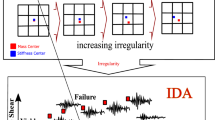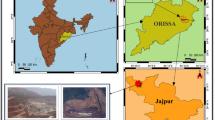Abstract
This paper investigates the deviation angle between the principal axis of a building and its vibration direction based on in-site full-scale testing carried out on existing old buildings in Algiers (Algeria). It presents results of a study on 67 reinforced concrete existing buildings. Analysis of empirical correlations introducing geometrical characteristics and analytical frequencies of the selected buildings is performed firstly. Secondly, fundamental frequency measures of some 36 buildings were carried out using the ambient vibration technique. The study shows that each of the tested buildings exhibit a direction of vibration that does not coincide with its orthogonal axes.












Similar content being viewed by others
References
Ait-Meziane Y, Lazzali F (2014) Ambient vibration experimental testing to evaluate seismic damage. Second European Conference on Earthquake Engineering and seismology 2ECEES, Istanbul, Turkey
Ait-Meziane Y, Djakab E, Benouar D, Esart II (2011) Vulnerability of the existing buildings (empirical evaluation and experimental measurement). Nat Hazard 62:189–206. https://doi.org/10.1007/s11069-011-9986-2
Ait-Meziane Y, Souici R, Guessoum N, Bouziane D, Abbes K (2018) Impact on the dynamic characteristics of reinforced concrete buildings in algiers following two seismic events. In Sundararajan N et al. (eds.), On significant applications of geophysical methods, advances in science, technology & innovation, 1stSpringer Conference of the Arabian Journal of Geosciences (CAJG-1), Tunisia 2018 : https://doi.org/10.1007/978-3-030-01656-2_44
Al-Kousa M, Tawfiq Hasan H, Abdul-wahed M, Alarab M, Al-egy I (2017) Experimental and analytical evaluation of the consolidation of tower 8 in the Damascus citadel. Arab J Geosci 10:37. https://doi.org/10.1007/s12517-016-2788-9
Boutin C, Ibraim E, Hans S, Rousillon P (2001) Etude expérimentale sur bâtiments réels, Technical report Association Française de Génie Parasismique (AFPS) et Ministère de l’Aménagement du Territoire et de l’Environnement, Paris, France (in French).
Breil J (1954) Données statistiques sur les immeubles et les logements : résultats statistiques du dénombrement de la population effectué le 31 octobre 1954, Service de statistique générale. Délégation générale du gouvernement en Algérie (in French)
Calvi GM, Pinho R, Crowley H (2006) State-of-the-knowledge on the period elongation of RC buildings during strong ground shaking. Proceeding of the 1st European Conference of Earthquake Engineering and Seismology, Geneva, Switzerland, September 2006, paper 1535
Carder DS (1936) Observed vibrations of buildings. Bull Seismol Soc Am 26:245–277
Chatelain JL, Guéguen P, Guillier B, Fréchet G, Bondoux F, Sarrault J, Sulpice P, Neuville JF (2000) CityShark: a user-friendly instrument dedicated to ambient noise (microtremor) recording for site and building response studies. Seismol Res Lett 71(6):698–703
Chatelain JL, Guillier G, Guéguen P, Fréchet J, Sarrault J (2012) Ambient vibration recording for single-station, array and building studies made simple: CityShark II.3. Int J Geosci 6A. https://doi.org/10.4236/ijg.2012.326118
Clotaire M, Guéguen P (2007) Analyse de vulnérabilité sismique à grande échelle par utilisation des propriétés dynamiques expérimentales des bâtiments. Proceeding of 7ème Colloque National AFPS 2007, Paris, France
Crowley H, Pinho R (2004) Period–height relationship for existing European reinforced concrete buildings. J Earthq Eng 8(1):93–119
Davidovici V (1999) La construction en zone sismique, Evreux, le Moniteur editions (in French)
Dunand F, Ait Meziane Y, Guéguen P, Chatelain JL, Guillier B, Ben Salem R, Hadid M, Hellel M, Kiboua A, Laouami N, Machane D, Mezouar N, Nour A, Oubaiche EH, Remas A (2004) Utilisation du bruit de fond pour l’analyse des dommages des bâtiments de Boumerdes suite au séisme du 21 mai 2003. Mém Service Géol d’Algérie 12:177–191 (in French)
Dunand F, Guéguen P, Bard PY, Rodgers J, Celebi M (2006) Comparison of the dynamic parameters extracted from weak, moderate and strong building motion. Proceeding of the 1st European Conference of Earthquake Engineering and Seismology, Genova, Switzerland
Eurocode 8 (2004) Design of structures for earthquake resistance—part1: general rules, seismic actions and rules for buildings, European Committee for Standardization (CEN), EN 1998-1, eurocodes.jrc.ec.europa.eu
Fandi M, Alyazjeen T (2013) Evaluation of site amplification, structural dynamic characteristics, and structural vulnerability rating of the city of Aqaba. Arab J Geosci 6:1465–1478. https://doi.org/10.1007/s12517-011-0444-y
Farsi MN, Bard PY (2004) Estimation des périodes propres de bâtiments et vulnérabilité du bâti existant dans l’agglomération de Grenoble. Revue Franç Génie Civil 8(2):149–179 (in French)
Farsi MN, Guillier B, Chatelain JL, Zermout S (2009) Retrofitting and strengthening evaluation from stiffness variations of a damaged building from ambient vibration recordings. In: Mucciarelli M, Herak M, Cassidy J (eds) Increasing seismic safety by combining engineering, NATO Science for Peace and Security, Series C: Environmental Security. Springer Sciences, Dubrovnik, Croatia, pp 227–238
Fat-Helbary RE, Abdel-latief AA, Mostafa A, Arfa MS (2016) Local site effects estimated from ambient vibration measurements at the Nubian habitations area in Kurkur, Aswan, Egypt. Arab J Geosci 9:609. https://doi.org/10.1007/s12517-016-2622-4
Gallipoli MR, Mucciarelli M, Šket-Motnikar B, Zupanćić P, Gosar A, Prevolnik S, Herak M, Stipčević J, Herak D, Milutinović Z, Olumćeva T (2010) Empirical estimates of dynamic parameters on a large set of European buildings. Bull Earth Eng 8(3):593–607
Guillier B, Atakan K, Chatelain JL, Havskov J, Ohrnberger M, Cara F, Duval AM, Zacharopoulos S, Teves-Costa P, Team SESAME (2008) Influence of instruments on the H/V spectral ratios of ambient vibrations. Bull Earthq Eng 6(1):331–331. https://doi.org/10.1007/s10518-007-9039-0
Housner GW, Brady AG (1963) Natural periods of vibration of buildings. J Eng Mech 89(8):31–65
Khalil L, Sadek M, Shahrour I (2007) Influence of the soil-structure interaction on the fundamental period of building. Earthq Eng Struct Dyn 36:2445–2453
Konno K, Ohmachi T (1998) Ground-motion characteristics estimated from spectral ratio between horizontal and vertical components of microtremor. Bull Seismol Soc Am 88(1):228–241
Lagomarsino S, Giovinazzi S (2006) Macroseismic and mechanical models for the vulnerability and damage assessment of current buildings. Bull Earthq Eng 4:415–443
Lestuzzi P, Badoux M (2013) Evaluation parasismique des constructions existantes. Presses polytechniques et universitaires romandes. Zurich, Suisse (in French)
Masi A, Vona M (2010) Experimental and numerical evaluation of the fundamental period of undamaged and damaged RC framed buildings. Bull Earthq Eng 8:643–656
Michel C, Guéguen P, Bard PY (2008) Dynamic parameters of structures extracted from ambient vibration measurements: an aid for the seismic vulnerability assessment of existing buildings in moderate seismic hazard regions. Soil Dyn Earthq Eng 28(8):593–604
Michel C, Guéguen P, Lestuzzi P, Bard PY (2010) Comparison between seismic vulnerability models and experimental dynamic properties of existing buildings in France. Bull Earthq Eng 8:1295–1307
Mohamed AA, El-Eraki MA, El-Kenawy AA, Mostafa SI (2016) Evaluating the structural model from ambient vibration recordings and shallow seismic refraction techniques. A case study of Zagazig City, Egypt. Arab J Geosci 9:617. https://doi.org/10.1007/s12517-016-2635-z
Oliveira CS, Navarro M (2010) Fundamental periods of vibration of RC buildings in Portugal from in-situ experimental and numerical techniques. Bull Earth Eng 8(3):609–642
SESAME (2005) User guideline for the implementation of the H/V spectral ratio technique on ambient vibration: measurement, processing and interpretation, European Commission–Research General Directorate Project No. EVG1-CT-2000-00026 SESAME, rep. D23.12, pp 62
RPA 88 Règles Parasismiques Algériennes (1988) Document Technique Réglementaire DTR B-C 2-48. Centre National de Recherche Appliquées en Génie Parasismique, Alger (in French)
RPA 99 version (2003) Règles Parasismiques Algériennes (2003) Document Technique Réglementaire DTR B-C 2-48. Centre National de Recherche Appliquées en Génie Parasismique, Alger (in French)
Trifunac MD (1972) Comparisons between ambient and forced vibration experiments. Earthq Eng Struct Dyn 1:133–150
Trifunac MD, Ivanovíc SS, Todorovska MI (2001a) Apparent periods of building I: Fourier analysis. J Struct Eng 127:517–526
Trifunac MD, Ivanovíc SS, Todorovska MI (2001b) Apparent periods of building II: Time frequency analysis. J Struct Eng 127:527–537
Acknowledgements
The authors would like to thank the DGRSDT (General Directorate of Scientific Research and Technological Development), ALGERIA, for the support of this research work. The authors would also like to express their sincere appreciation to the LBE Laboratory of Civil Engineering Faculty (USTHB) and the National Earthquake Research Center (CGS), ALGERIA, for their support.
Author information
Authors and Affiliations
Corresponding author
Additional information
Responsible Editor: David Giles
Rights and permissions
About this article
Cite this article
Souici, R., Ait-Meziane, Y. & Benouar, D. Identification of vibration direction of existing buildings using ambient vibration noise tests. Arab J Geosci 14, 24 (2021). https://doi.org/10.1007/s12517-020-06306-6
Received:
Accepted:
Published:
DOI: https://doi.org/10.1007/s12517-020-06306-6




